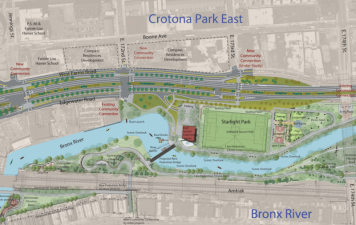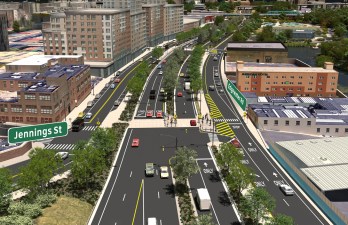Sheridan Alternatives Offer Hope for Surface Road in Place of Expressway

While the city’s refusal to remove the Sheridan Expressway left South Bronx advocates frustrated, the fight to transform the under-used highway continues, with the city’s federally-funded planning study on track for completion in June. A presentation to community partners last week [PDF] shed new light on options the city is considering, offering some hope that the highway’s footprint could be drastically reduced, essentially becoming a surface road.
The presentation to the project’s community working group on March 7 was led by Tawkiyah Jordan, Sheridan Expressway project manager for the Department of City Planning, and Michael Marsico, assistant commissioner of modeling and data analysis at NYC DOT.
Four options were analyzed:
- “No build” would not modify the existing street and expressway network;
- “Retain” keeps the Sheridan Expressway as-is but adds direct ramps from Oak Point Avenue in Hunts Point to the Bruckner Expressway;
- “Modify-Separated” converts the Sheridan to a street-level boulevard, while also retaining the parallel West Farms Road and adding the Oak Point ramps;
- “Modify-Combined” merges the Sheridan with West Farms Road, creating a single street-level boulevard, while also adding the Oak Point ramps.
Prior to last week’s meeting, the city said only that it was considering an undefined “modify” scenario, along with “no build” and “retain.” Splitting the “modify” option into the “separated” and “combined” alternatives is a big step forward. Both would significantly alter the Sheridan between Westchester Avenue and the the Cross Bronx Expressway, leaving the southern section near Concrete Plant Park, which is adjacent to an Amtrak rail corridor, mostly untouched.
The two modify scenarios would also provide space for new development and bring pedestrian crossings to street level. Under the “separated” scenario, the road right-of-way would be narrowed from the existing 210 feet to approximately 155 feet; under the “combined” option, it would be reduced further to an estimated 115 feet.
DOT prepared a traffic analysis for each of these alternatives, projecting traffic volumes in 2035 during morning and evening periods, from 6-10 a.m. and 4-8 p.m. DOT looked at the number of trucks, total vehicle miles traveled, and travel times.
One missing component is vehicle emissions. At last week’s meeting, DOT agreed to analyze air quality impacts of each alternative and present the results in April.
The traffic analysis left the Tri-State Transportation Campaign’s Vincent Pellecchia optimistic, writing that “traffic on most local roads would be reduced without a discernible impact on overall travel times.” However, advocates continue to be cautious because the exact design of each scenario remains unclear. Alterations to the design could increase truck traffic on Southern Boulevard, an outcome the advocates are looking to avoid.
In addition, the Oak Point ramps DOT studied are only for traffic coming from or going to the east on the Bruckner Expressway. Advocates had wanted both east and west ramps, and are asking DOT to study this configuration, as well.
All alternatives except “no build” remove the on-ramp from the intersection of Bruckner Boulevard and Hunts Point Avenue to the northbound Sheridan Expressway. TSTC is asking DOT to also study the impacts of closing the ramp from the Sheridan northbound at Westchester Avenue. Removing the ramp would create opportunities for development, decking over the parallel Amtrak rail line and connecting to the northern edge of Concrete Plant Park.
City staff will present to the community working group again in April. In June, the city is expected to release its recommendations.


